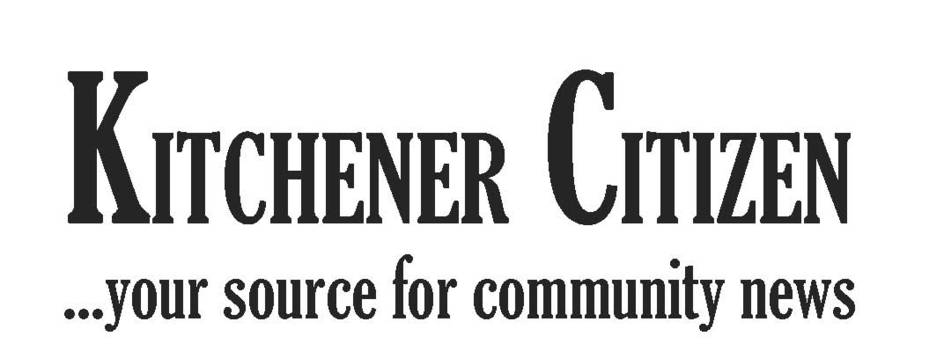

BILL HERON COULD BE CANADA’S GREATEST GOLF FAN
Canadian golf history uniquely, passionately preserved
Canadian golf history uniquely, passionately preserved
For News Tips & Advertising call...
Kitchener East - 519-578-8228
Kitchener West - 519-741-5892
 By Carrie Debrone
By Carrie DebroneKitchener Citizen
If there’s one thing people love it’s a good story. No one knows that better than Kitchener’s golf historian Bill Heron.
“I live to tell them,” the 75-year-old Heron says in his still-distinctive Scottish brogue and with a twinkle in his eye during a recent interview at his Kitchener home.
“I eat, sleep and dream the game of golf. I love the game with a passion. There are so many good stories in golf and so many great characters that have played the game,” he said.
It is doubtful that the game has a greater fan than Heron.
Although he never became a golf pro himself, Heron has played at every British Open golf course in Scotland and has taught several close friends and relatives to play.
Almost since the day he could walk, he has played golf, learning the game, as almost every child did, while growing up in his native Scotland.
After moving to Canada he maintained his passion for the game. For 45 years he has never missed the Canadian Open at Glen Abbey and from 1996 to 2010 he served as one of its marshals, in charge of crowd control for the open at the world famous greens located in Oakville, Ontario.
Although he had to give up playing about eight years ago because of arthritis in his knees, brought on by the 55 previous years of climbing ladders to complete his work as a house painter and by years of playing soccer, he still loves to tell golf stories.
And, the way he best likes to deliver them is by showing the numerous items from his continuing collection of unique golf artifacts - a collection he has displayed numerous times at golf shows and events over the years.
His collection contains one-of-a-kind items that he has created to use as teaching tools, as well as original items he has preserved for their historical value. But the largest part of the collection is based on the life of one of Canada’s greatest golf legends -- Kitchener golfer Moe Norman.
Norman died in 2004 on the eve of the 100th anniversary of the Bell Canadian Open, at the age of 74.
A close friend of Norman’s, Heron made a promise to Norman before he died.
“I promised Moe that when I die, people will know there was a Moe Norman. I promised him that I would record him in Canadian golf history. That’s why I have this collection,” he said.
Although Norman was one of the best golfers in the history of the game, and remembered for his unusual lock-kneed, legs apart, rigid-legged driving stance, and his ability to strike a ball with great accuracy and drive it great distances, he never rose to celebrity status because of his strange personality.
“He was not normal. His nature and mannerisms were very strange,” Heron said. “Maybe he had autism, but it was never diagnosed because he never went to a doctor in his whole life,” Heron said.
“I just accepted him for who he was,” Heron said.
As expected Heron’s collection contains numerous newspaper clippings and magazine articles written on Norman’s career, and those written after he died. But it’s the items that Heron has carefully and uniquely preserved or thought of saving in a unique way that really grab your interest.
There’s a 1970s Timex watch with Moe’s picture on the face. Norman was popular in the 1970s when Canada use to hold its own PGA tours.
Heron has Moe Norman’s scorecard from a game he played in 1957 with Gary Cowan, Bob Patterson and Lloyd Niziol at Kitchener’s Rockway Golf Course, where Norman shot a 59 (par was 72) - betting a dime a hole and winning about 90 cents, enough to buy Norman his dinner.
There’s a photo of Tiger Woods meeting Norman for the first time taken by Heron’s friend Ron Paré in 2000 and signed by Norman; one dozen Moe Norman golf balls, likely the only ones in existence; Norman’s playing record of the games he played at the Masters in Augusta, Georgia, replica invitations (obtained from the Masters’ archives and signed by Moe Norman) of the invitations Norman received to play at the masters in 1956 and 1957 – the same years that the famous golfer won Canadian amateur golf titles; personalized stamps with Moe Norman’s photo on them; a replica of a painting of Moe Norman (also signed by Norman) that was done by the famous California sports artist, Leroy Neiman and a replica of Norman’s personal putter that eventually came to be known as The Thing, and Heron’s handmade flip page swing sequence book showcasing Norman’s unique golf swing from the hundreds of photos he took of Norman hitting the ball (Heron also compiled swing sequence books for Tiger Woods and Ben Hogan and other golf greats) are only a few of the items in his collection.
All are carefully preserved and most are contained in their own boxes handcrafted by Heron, some lined with velvet, and then skillfully covered with Scottish tartan design paper.
But the one item that really stands out in Heron’s Moe Norman collection is a sculpture scene carved out of bass wood by London artist Phil Orchard who created it from a drawing done by Heron.
The sculpture shows Norman holding his golf club high in the air over his head as he watched the ball he had just hit – something that he did so often it became almost as famous as his unusual driving style. Heron personally carved the sculpture’s small wooden golf club.
About 16 inches wide, 24-inches tall and two inches thick, the border and back of the sculpture contains 265 signatures of the most famous golfers of our time, as well as three hockey players – Marcel Dionne, Wayne Gretzky and Eddie Shack.
Not only has Heron met every one of the players who have signed his sculpture, but also he has carefully documented when, where and in what order each player signed. Heron allowed each golf celebrity to choose where he would like to sign so all the signatures are randomly placed.
Tiger Woods’ signature, the 99th one he received, was captured at Woods’ first professional tournament when he was only 20 years old.
“He didn’t even know who Moe Norman was. He said, Moe who?” Heron said.
Heron generously allowed his sculpture to be placed on display at the Glen Abbey Hall of Fame from 2005 – 2007.
Norman left all his trophies to Heron when he died and Heron has kept a few, but most he donated to Gus Maue.
“I’ve never met another Canadian golfer who did it all, like Moe,” said Heron.
Heron’s collection also includes a variety of items that Heron uses to teach the history of golf, like the replica set of 11 antique hickory shafted perforated water irons he designed and made to teach people the history of golf clubs.
Water irons, with their mini-rake-like heads, were first used in Scotland in 1905 because there was so much water on the golf courses at St. Andrews. The heads allowed the water to pass through them rather than pushing it along with the ball.
However, the clubs were banned in 1910 when it was deemed that everyone playing golf should use the same type of club in order to standardize play.
Heron has a tartan-shafted golf club, which he says is the only one in the world.
One of Heron’s best golf stories is a very personal one. Heron, who knows Walter Gretzky, asked if he could bring his grandson Chris, who had been diagnosed with brain cancer, to see the collection of Wayne Gretzky memorabilia kept by his father who often showed it to school tours.
“Of course he said. Bring your grandson over,” Heron recalled.
As luck would have it, while in the basement of the Gretzky home with his grandson, almost hidden in a pile of used hockey sticks in a corner, Heron spied a golf club.
He brought it out and asked where it had come from.
Heron was captivated by the story that Walter Gretzky then told him.
Bob Hope had given the club to Wayne Gretzky after they talked about their golf games while sharing first class on a flight more than 30 years before.
“Walter said, “Take it. Keep it. I told him I would tell the golf story that went along with that club,” Heron said.
Heron’s teaching collection also includes a book about the history of the golf ball from its beginnings to current manufacturing with a listing of all golf ball manufacturers and prices as well as a replica early golf ball, which was constructed by filling a round leather pouch with feathers.
He has constructed the world’s smallest hard cover golf book containing photos of all the great players from the 1940s to the 1980s. He recorded Tiger Woods’ Canadian golf championship win in 2000 on a six-sided, fold out cube that reveals a different magazine photo of Woods at the tournament on each side.
Heron continues to preserve the history of current day professional golfers, including Canadian golfer Mike Weir from Brights Grove, Ontario, winner of the 2003 Masters.
Heron made five books containing the newspaper and magazine articles he sourced from McLean’s, the Globe and Mail, the Toronto Star and Score Golf magazine to name a few, giving four of them to Weir’s parents and siblings.
“If you show me a golf object, I’ll give you three good stories about it. It’s the greatest game on earth,” Heron said.